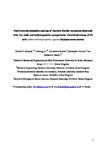Multilayered composite coatings of titanium dioxide nanotubes decorated with zinc oxide and hydroxyapatite nanoparticles: Controlled release of Zn and antimicrobial properties against staphylococcus aureus
| dc.contributor.author | Gunputh, U | |
| dc.contributor.author | Le, H | |
| dc.contributor.author | Besinis, A | |
| dc.contributor.author | Tredwin, C | |
| dc.contributor.author | Handy, R | |
| dc.date.accessioned | 2019-05-03T07:07:35Z | |
| dc.date.issued | 2019-05-16 | |
| dc.identifier.issn | 1176-9114 | |
| dc.identifier.issn | 1178-2013 | |
| dc.identifier.uri | http://hdl.handle.net/10026.1/13770 | |
| dc.description.abstract |
Purpose: This study aimed to decorate the surface of TiO2 nanotubes (TiO2 NTs) grown on medical grade Ti-6Al-4V alloy with an antimicrobial layer of nano zinc oxide particles (nZnO) and then determine if the antimicrobial properties were maintained with a final layer of nano-hydroxyapatite (HA) on the composite. Methods: The additions of nZnO were attempted at three different annealing temperatures: 350, 450 and 550 °C. Of these temperatures, 350°C provided the most uniform and nanoporous coating and was selected for antimicrobial testing. Results: The LIVE/DEAD assay showed that ZnCl2 and nZnO alone were >90% biocidal to the attached bacteria, and nZnO as a coating on the nanotubes resulted in around 70% biocidal activity. The lactate production assay agreed with the LIVE/DEAD assay. The concentrations of lactate produced by the attached bacteria on the surface of nZnO-coated TiO2 NTs and ZnO/HA-coated TiO2 NTs were 0.13±0.03 mM and 0.37±0.1 mM, respectively, which was significantly lower than that produced by the bacteria on TiO2 NTs alone, 1.09±0.30 mM (Kruskal-Wallis, P<0.05, n=6). These biochemical measurements were correlated with electron micrographs of cell morphology and cell coverage on the coatings. Conclusion: nZnO on TiO2 NTs was a stable and antimicrobial coating, and most of the biocidal properties remained in the presence of nano-HA on the coating. | |
| dc.format.extent | 3583-3600 | |
| dc.format.medium | Electronic-eCollection | |
| dc.language | en | |
| dc.language.iso | en | |
| dc.publisher | Dove Medical Press | |
| dc.rights | Attribution-NonCommercial-NoDerivatives 4.0 International | |
| dc.rights | Attribution-NonCommercial-NoDerivatives 4.0 International | |
| dc.rights | Attribution-NonCommercial-NoDerivatives 4.0 International | |
| dc.rights | Attribution-NonCommercial-NoDerivatives 4.0 International | |
| dc.rights | Attribution-NonCommercial-NoDerivatives 4.0 International | |
| dc.rights | Attribution-NonCommercial-NoDerivatives 4.0 International | |
| dc.rights | Attribution-NonCommercial-NoDerivatives 4.0 International | |
| dc.rights | Attribution-NonCommercial-NoDerivatives 4.0 International | |
| dc.rights | Attribution-NonCommercial-NoDerivatives 4.0 International | |
| dc.rights | Attribution-NonCommercial-NoDerivatives 4.0 International | |
| dc.rights.uri | http://creativecommons.org/licenses/by-nc-nd/4.0/ | |
| dc.rights.uri | http://creativecommons.org/licenses/by-nc-nd/4.0/ | |
| dc.rights.uri | http://creativecommons.org/licenses/by-nc-nd/4.0/ | |
| dc.rights.uri | http://creativecommons.org/licenses/by-nc-nd/4.0/ | |
| dc.rights.uri | http://creativecommons.org/licenses/by-nc-nd/4.0/ | |
| dc.rights.uri | http://creativecommons.org/licenses/by-nc-nd/4.0/ | |
| dc.rights.uri | http://creativecommons.org/licenses/by-nc-nd/4.0/ | |
| dc.rights.uri | http://creativecommons.org/licenses/by-nc-nd/4.0/ | |
| dc.rights.uri | http://creativecommons.org/licenses/by-nc-nd/4.0/ | |
| dc.rights.uri | http://creativecommons.org/licenses/by-nc-nd/4.0/ | |
| dc.subject | Zinc oxide nanoparticles | |
| dc.subject | TiO2 nanotubes | |
| dc.subject | hydroxyapatite | |
| dc.subject | antimicrobial | |
| dc.subject | Staphylococcus aureus | |
| dc.title | Multilayered composite coatings of titanium dioxide nanotubes decorated with zinc oxide and hydroxyapatite nanoparticles: Controlled release of Zn and antimicrobial properties against staphylococcus aureus | |
| dc.type | journal-article | |
| dc.type | Article | |
| plymouth.author-url | https://www.ncbi.nlm.nih.gov/pubmed/31190813 | |
| plymouth.volume | 14 | |
| plymouth.publication-status | Published online | |
| plymouth.journal | International Journal of Nanomedicine | |
| dc.identifier.doi | 10.2147/IJN.S199219 | |
| plymouth.organisational-group | /Plymouth | |
| plymouth.organisational-group | /Plymouth/Faculty of Health | |
| plymouth.organisational-group | /Plymouth/Faculty of Health/Peninsula Dental School | |
| plymouth.organisational-group | /Plymouth/Faculty of Science and Engineering | |
| plymouth.organisational-group | /Plymouth/Faculty of Science and Engineering/School of Biological and Marine Sciences | |
| plymouth.organisational-group | /Plymouth/Faculty of Science and Engineering/School of Engineering, Computing and Mathematics | |
| plymouth.organisational-group | /Plymouth/REF 2021 Researchers by UoA | |
| plymouth.organisational-group | /Plymouth/REF 2021 Researchers by UoA/UoA03 Allied Health Professions, Dentistry, Nursing and Pharmacy | |
| plymouth.organisational-group | /Plymouth/REF 2021 Researchers by UoA/UoA06 Agriculture, Veterinary and Food Science | |
| plymouth.organisational-group | /Plymouth/REF 2021 Researchers by UoA/UoA12 Engineering | |
| plymouth.organisational-group | /Plymouth/Research Groups | |
| plymouth.organisational-group | /Plymouth/Research Groups/Marine Institute | |
| plymouth.organisational-group | /Plymouth/Users by role | |
| plymouth.organisational-group | /Plymouth/Users by role/Academics | |
| dc.publisher.place | New Zealand | |
| dcterms.dateAccepted | 2019-03-21 | |
| dc.rights.embargodate | 2019-9-13 | |
| dc.identifier.eissn | 1178-2013 | |
| dc.rights.embargoperiod | Not known | |
| rioxxterms.versionofrecord | 10.2147/IJN.S199219 | |
| rioxxterms.licenseref.uri | http://creativecommons.org/licenses/by-nc-nd/4.0/ | |
| rioxxterms.licenseref.startdate | 2019-05-16 | |
| rioxxterms.type | Journal Article/Review |



